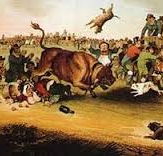Bull Baiting History

By the time bull baiting reached England, it was, by no means, a new “sport”. Many ancient civilizations including the Egyptians, Greeks, and Romans had participated in similar pastimes. However, it was the sport’s popularity in England during the Middle Ages that gave rise to the ancestors of the modern day Bulldog.
Bull baiting consisted of pitting dogs against bulls. The bulls were tied to an iron stake that was subsequently bolted into the ground. The dogs’ goal was to pin down the bulls by grabbing onto their snouts, the most sensitive part of the bull’s body, and wrestling with the animals until the dogs had turned them on their sides.
Of course, the bulls didn’t go down without a fight. If the dogs weren’t careful, they risked being gored by the bulls’ horns, trampled under hooves, or chewed up by the bulls’ powerful teeth. Dogs that managed to grab onto the bulls’ noses were shaken violently as the bulls tried to throw them off. This often resulted in serious brain and bodily injuries such as broken teeth and bones.
Although bulls were the most popular animal to use, bears, horses, and other animals were pitted against dogs in a similar manner. These events usually took place in coliseum-type buildings with amphitheater seating so everyone could get a view. These buildings were often surrounded by kennels of dogs waiting for their turns in the ring.
The practice was fueled by money, with people from every class–rich to poor–placing bets and watching the fights. According to a description written in the Chamber’s Book of Days by the French Advocate Mission who had lived in England when King William the Third reigned, it was quite a spectacle. The bulls and dogs were decorated with flowers and ribbons and paraded through the streets. The parade would end in the center of the ring with the bulls being tied to the stakes, soon after which the dogs were set upon them.
It’s unknown exactly how bull baiting started. The first reported bull baiting event took place in 1209 at Stamford during the reign of King John. However, there is a rumor that the sport developed much earlier than that due to an incident witnessed by the Earl of Warren. According to writings by Latin poet Claudius Claudianus (colloquially known as Claudian), the Earl of Warren was observing two bulls fighting for the right to mate with a cow. Suddenly, a group of dogs owned by local butchers set upon the bulls and chased them through town. The earl enjoyed the sight of this madness so much he set aside land near his castle for the butchers. His only condition was they had to repeat the incident by having the dogs chase a bull around six weeks prior to Christmas Day.
Whether or not this is true is up for debate. What can’t be argued, however, is how popular the bull baiting became in England. From the 13th to the 18th centuries, it was considered a national sport, and dogs were selectively bred to fill the role of antagonists in the ring.
In the beginning, large dogs similar in size to Mastiffs were sent to battle the bulls. It quickly became obvious, however, that the dogs were too slow and awkward in the ring. Breeders began crossing breeds to create a dog with most of its weight distributed to the front of its body. This reduced the risk of the dog’s back breaking when it was shaken by the bull. The dogs were also smaller, which made it easier for them to evade the bulls’ horns. Personality-wise, the dogs were bred for aggression, courage, and tenacity; traits that would help them take on and take down animals 10 times their size.
Today’s modern breeding programs with its focus on pedigree didn’t exist back then. Instead, breeders matched males and females based on their individual characteristics. Records are filled with stories illustrating this. One such story can be found in the January 1824 issue of Sporting Magazine.
In the anecdote, a butcher brought a female dog and her litter of puppies to a bull-baiting event. She was a sorry looking thing with no teeth. However, the butcher was confident enough in the dog’s abilities that he exclaimed to the room he didn’t need to say a word about her abilities because she would prove exactly how good she was. When he loosed her onto the bull, she pinned the animal within mere minutes. Ultimately he had to put her down because she wouldn’t let go of the bull, but he managed to sell her puppies to the crowd for 5 guineas each.
Another story provides gruesome evidence of just how relentless a Bulldog can be. With the utmost confidence in his dog, an Englishman bet he could cut off each of his dog’s feet and it would continue to attack the bull regardless of its injuries. One after another, he cut the poor dog’s feet off at varying intervals and the dog continued to attack the bull as he predicted. Mercifully, he put the dog down soon after.
The life of Bulldogs during that time period was filled with the same, if not similar, types of horrific treatment. It was fairly common to see gravely injured dogs–with entrails trailing behind them–being pushed to attack over and over again. The dogs were gored, shaken violently, and even trampled. A writer reported one incident where a bison, pinned by the dog, reared up and stomped the dog to death to get out of its grip.
Like most things, money was the primary motivator for such atrocities. However, people also found the spectacles highly entertaining, and other exhibitions were thrown into the mix to attract viewers. Dogs would be made to chomp on a sponge attached to a rope and raised into the air by their teeth while fireworks exploded around them. It wasn’t unusual for boxing matches to precede or follow bull-baiting events. In fact, in 1824, approximately 5,000 people sat through a bull baiting and a subsequent boxing match.
Bull baiting had become such a pervasive part of English culture that butchers were required to bait bulls before slaughtering them. It was believed that bull baiting made the meat more tender and nutritious. A court roll from the Manor at Barnard Castle advised butchers that bulls over two years of age must be put in the ring prior to butchering. Any butcher found selling non-baited bull meat would be fined and face other penalties. Incidentally, a breed of Bulldogs known as Lonsdales was named after a butcher who lived in Barnard Castle around 1780. These dogs were very popular for several years during that time.
Thankfully, a movement to ban bull baiting soon arose. A bill was introduced to the House of Commons in 1802, but it was thrown out. However, opponents were successful in making bull baiting illegal in 1835. Unfortunately, people still continued to partake in it for several years afterwards. It wasn’t until about 1842 that the last bull baiting matches were held in Lancashire and Ashbourne.
Bulldogs had been bred specifically for the sport. Since it was no longer being practiced, the breeds’ numbers rapidly declined. Part of this was because dog fighting became popular, and many Bulldogs were killed fighting other dogs. It is believed that Bulldogs were mixed with Terriers to create animals that would do better in this sort of match.
Lucky for Bulldogs, some were exported to Germany where they were crossbred with other breeds to create Boxers. Others were transplanted to France and America, where they were further reduced in size and became the lovable dogs we know today.
Bulldogs did have their fans in England. An 1809 engraving made of three dogs named Billy, Wasp, and Child had notes in the margin that stated they were the property of a solicitor named H. Boynton. The dogs were from a breed owned by the Duke of Hamilton and considered very valuable. The solicitor was able to fetch 140 guineas for two of the dogs and speculated that the breed may soon become extinct.
As we all know, the dogs didn’t become extinct. Despite its harsh history, the Bulldog has become a thriving breed valued for its courage and loyalty. Take time to appreciate how far your pet has come.

